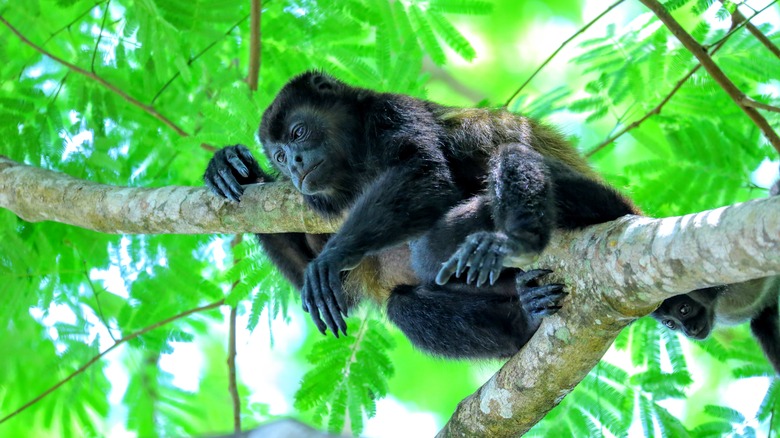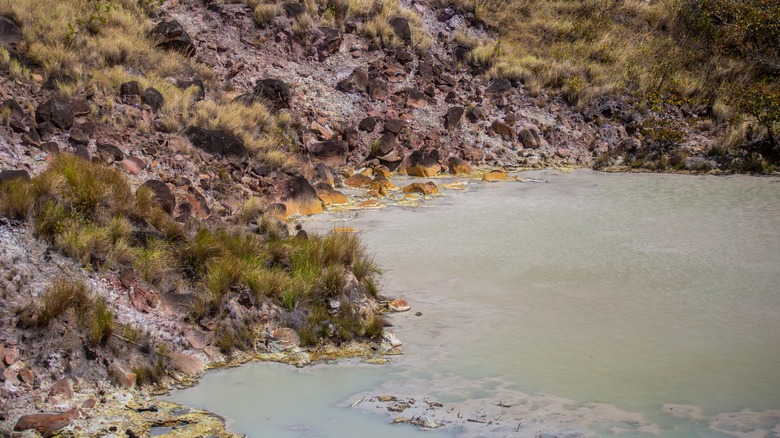The 'Yellowstone Of Costa Rica' Is A Little-Known Jungle Hot Spring Haven Of A National Park
We may receive a commission on purchases made from links.
Encompassing an area of less than 20,000 square miles — about the size of West Virginia — Costa Rica is home to a whopping 30 national parks. The Central American country located between Nicaragua and Panama is a nature-lover's paradise for hiking, white water rafting, ziplining, and more. Rincon de la Vieja National Park is located within the confines of Area de Conservación Guanacaste, a designated UNESCO World Heritage Site and one of the best things to do in Costa Rica. The expansive protected area stretches through diverse habitats — marine coastal, mountain, low country rainforest, and savannas — from the Pacific coast to the Caribbean basin.
Rincon de la Vieja National Park, near the town of Liberia in the conservation area's northwestern quadrant, is named for Rincon de la Vieja, the largest and most active volcano in the province of Guanacaste. Nicknamed "Colossus of Guanacaste," the 6,286-foot-tall volcanic peak that bridges the Continental Divide is 9 miles wide and has nine individual volcanic craters. The national park has two distinct sections within the 34,000-acre parcel of land surrounding Rincon de la Vieja, and trails through Las Pailas offer the best views of the volcano and its impact on the surrounding terrain.
Highlights include fumaroles (surface holes) spouting steam and sulfur, and bubbling masses of volcanic clay. More than 300 species of wildlife, ranging from armadillos and iguanas to howler monkeys and spider monkeys, inhabit the ecosystem. The other section, Santa Maria, is a place of waterfalls and hot springs that rival those at Yellowstone National Park. The cool thing — pun intended — is the springs in Santa Maria are temperate enough for safe swimming. And while it's feasible to explore either section on your own, sometimes having a guide who knows the area can add depth to your experience and point out highlights you may otherwise miss.
Guided tours at Rincon de la Vieja National Park
U.S.-based tour consolidator Viator offers dozens of ways to explore Rincon de la Vieja National Park. Tours usually include transportation to and from the origination point along with any special equipment required for specific itineraries. Eco-curious hikers may want to opt for the Active Volcano Walk. The full-day tour involves a two-hour mountainside hike to the rim of a steaming caldera — the depression that forms after a volcano erupts leaving the magma chamber empty and vulnerable to collapse — and a glimpse into the netherworld of an active volcanic landscape.
John_D, a recent visitor to Costa Rica who participated in the Active Volcano Walk, had rave reviews for the tour and their guide, whose personal knowledge added dimension to their experience. "Jose is a connoisseur of nature and his knowledge of the volcano area is unparalleled," they wrote in a review on the Viator website. "He can point out animals and creatures that I would have walked by. He has a great route through the park that I would not have taken without his expertise."
Make the most of a visit to Rincon de la Vieja National Park
Costa Rica's Rincon de la Vieja National Park is open year-round except on Mondays, although storms in the rainy season (May to November) can affect trail conditions. Regardless of the season, a few supplies can make the difference between a banner day and a bad day. Leave your cute sandals in your suitcase. Hiking Rincon de la Vieja requires sensible closed-toe shoes. At the very least, wear sneakers. Ideally, opt for hiking boots. Sunscreen is essential and a hat is a good idea. Bug spray will definitely come in handy. Unless your tour includes snacks, bring a few energy bars or a bag of granola. And, of course, water. Be advised: Plastic water bottles are prohibited within the park, so a reusable water bottle is essential.
When it comes to lodging, Hacienda Guachipelin is a go-to choice for convenience. Located at an active cattle ranch adjacent to Rincon de la Vieja National Park, the grounds of Hacienda Guachipelin encompass beautiful thermal hot springs and volcanic mud basins. There's an on-site spa and a forest-engulfed yoga deck. The hotel is also home to a highly regarded restaurant, Nekajui, centered on an antique mud oven. Opened in 1999, Borinquen Thermal Resort in Guanacaste was purpose-built to showcase the natural beauty of the Rincon de la Vieja region. The property features thermal springs with hot pools and a spa offering volcanic mud treatments. Private villas and bungalows are situated to take full advantage of the spectacular sunset. With a focus on sustainability and eco-tourism, Granja Integral Luz del Corazon offers healing retreats with accommodations ranging from hostel-style lodging to private riverside bungalows.
Legendary healing powers of Rincon de la Vieja
In a place so focused on nature and the volcanic landscape, we'd be remiss if we didn't mention the legend of Rincon de la Vieja which, in English, means "corner of the old woman." It starts with a tale of star-crossed lovers — a chieftain's daughter, Princess Curubandá, and the son of a rival tribe's leader, Prince Mixcoac, fell in love. The girl's father was so incensed when he discovered the secret relationship, he threw the young prince into the volcano. Heartbroken, the princess spent the rest of her life on the slope of the volcano mourning her lover's death. During her self-appointed exile, she became an expert on natural remedies. Locals, who believed she had healing powers, sent people who needed medical attention to "the corner of the old woman."
The legend of Princess Curubandá goes back to the 15th century. Whether her story is true or not, the people living in the region at the time believed in the healing powers of bathing in thermal hot springs and basking in a coating of volcanic mud. Even today, medical practitioners acknowledge the benefits of bathing in thermal waters, especially for the treatment of skin ailments. Intrigued? Vandará, located on the slope of the Rincon de la Vieja Volcano where Princess Curubandá is said to have lived out her life, offers day passes for visitors looking to immerse themselves in an experience that goes back centuries.



